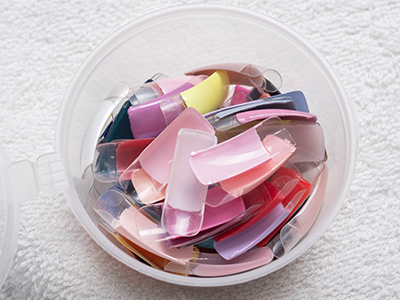Today, every second modern girl is building up her nails. After all, not everyone has long nails by nature, so the technology of «nail extension» runs to help. It is known that in the process of nail extension the master can use tips or forms. Surely everyone asks himself the question, which is better, tips or forms. Many people think that nail tips greatly enhance natural nails. Others are of the opinion that building on forms looks more natural. In general, there are no comrades for «taste and color», so in this article we will try to describe each process individually, but of course the choice will be yours.
To begin with, let's define tips and forms for nail extension.
WHAT ARE TIPS OR «OVERLAY» BUILD-UP?
Nail tips are ready-made plastic overlays of a certain thickness that repeat the shape of the nail. They are made of durable elastic material that is completely safe for human health. The length can be formed at your discretion. They are designed to simulate a natural nail.
Tips distinguish between:
1. According to the contact zone - the place where the tipsa sticks to the nail. The contact area can be large or small, deep or not, and there are tips and generally without it (contactless).
2. By shape - tips are straight, classic (with a slight bend), curved, narrowed, etc. They also come in different lengths, but they are usually made quite long.
3. By color - tips are of natural color, transparent, colored and with design. French tips are used to create French manicure. They are usually contactless and very this.
WHAT ARE GROWTH FORMS?
Shapes are fixtures (templates or stencils) that fit under the edge of a natural nail. On which the material for building is laid out. Depending on the materials used, the forms are disposable or reusable. Disposable forms are more convenient as they can be adapted to any nail plate. On the surface of the template, there are marks indicating the size of the nails, which helps the master to immediately shape the length.
WHEN TO USE TIPS AND WHEN SHAPES?
What to choose, of course, is the client's desire, but you also need to take into account the condition of the nails, so read and take note.
1. Oval or almond-shaped. This shape of the nail is considered classic and in this case, both the first and the second method of extension are suitable. One has only to remember that for forms it is necessary that the free edge of the nail protrudes at least 1-2 millimeters. If there is no free edge, then only tips are suitable here.
2. Flat nails. Both tips and shapes are suitable, but you should pay attention to the width of the nail bed: if it is too wide, then use shapes, since in some cases the width of the tips may not be enough.
3. «Bitten» nails. It is better to build on tips with a small contact area. The surface of the bitten nails is always uneven, the nail seems to sink into the high pads of the fingers. In this case, the master needs to carefully file off all the irregularities and create a flat surface for gluing the tips.
4. Normal nails. If the nails have the correct, almond-shaped shape, then there will be no problems with the choice of the extension method and the master can offer any of the two6 shapes or tips.
5. The nails are bent down. In this case, only forms will work. Moreover, the shape must be selected along the smile line under the natural nail.
6. Trapezoidal nails. When building on such nails, tips with a small contact area are used, which have a pronounced S-bend. If you use classic tips, then their wear period is sharply reduced. Before building such nails, you need to file them shortly.
In the process of nail extension, always choose a method based not only on the desire, but also on the condition of the nails. Then your nails will be beautiful and attractive.
